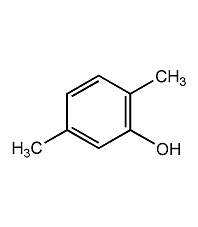
structural formula
| business number | 02a2 |
|---|---|
| molecular formula | c8h10o |
| molecular weight | 122.16 |
| label |
1-hydroxy-2,5-xylene, 2-hydroxy-p-xylene, p-xylenol, 6-methyl m-cresol, 1,4-dimethyl-2-hydroxybenzene, 2-hydroxy-p-xylene, p-xylenol, 2,5-dimethylphenol, 6-methyl-m-cresol, 1,4-dimethyl-2-hydroxybenzene, disinfectant, phenolic solvents, drug, plasticizer, d |
numbering system
cas number:95-87-4
mdl number:mfcd00002237
einecs number:202-461-5
rtecs number:ze5775000
brn number:1099260
pubchem number:24893530
physical property data
1. properties: white crystal.
2. boiling point (ºc, 101.3kpa): 211.5
3. boiling point (ºc, 13.3kpa): 143
4. boiling point (ºc, 2.67 kpa): 105
5. melting point (ºc): 74.8
6. relative density (g/ml, 25/25ºc, solid): 1.189
7. relative density (g/ml, 80/4ºc): 0.9770
8. flash point (ºc): 85
9. kinematic viscosity (m2
sup>/s, 80ºc): 1.61×10-6
10. kinematic viscosity (m2/s, 120ºc): 0.825×10 -6
11. kinematic viscosity (m2/s, 160ºc): 0.528×10-6
12. heat of evaporation (kj/mol): 46.97
13. heat of generation (kj/mol): 246.85
14. heat of combustion (kj/mol) : 4333.51
15. critical temperature (ºc): 449.9
16. vapor pressure (kpa, 92ºc): 1.33
17. solubility (%, 25ºc , water): 0.25
18. solubility: hardly soluble in water, miscible with ethanol, chloroform, ether, benzene, etc. soluble in sodium hydroxide aqueous solution.
19. refractive index at room temperature (n25): 1.511975
20. relative density (25℃, 4℃ ): 0.899160
21. relative density (20℃, 4℃): 0.977080
22. crystal phase phase standard heat of combustion (enthalpy) (kj·mol-1): -4330.6
23. crystal phase standard claims heat (enthalpy) (kj·mol-1): -246.6
24. gas phase standard combustion heat (enthalpy) (kj·mol-1): -4415.6
25. gas phase standard claimed heat (enthalpy) (kj·mol -1): -161.6
26. gas phase standard entropy (j·mol-1·k-1) : 395.87
27. gas phase standard formation free energy (kj·mol-1): -39.5
28. gas phase standard hot melt (j·mol -1·k-1):157.09
toxicological data
1. acute toxicity: rat oral ld50: 444mg/kg; rat ld50: 730mg/kg; kg;
2. chronic toxicity/carcinogenicity
mouse skin contact tdlo: 4000mg/kg/20w-i;
3. vapor to eyes it has an irritating effect on respiratory tract mucosa.
ecological data
will not biodegrade. bod5 (five-day biological oxygen demand): 0 this substance is harmful to the environment. special attention should be paid to the pollution of air, water environment and water sources.
water hazard class 3 (german regulations) (self-assessment via list): extremely hazardous to water.
do not allow this product to come into contact with groundwater, waterways, or sewage systems, even in small amounts.
even extremely small amounts of product seeping into the ground can pose a hazard to drinking water.
it is also poisonous to fish and plankton in water bodies.
do not discharge materials into the surrounding environment without government permission.
toxic to organic matter in water.
molecular structure data
1. molar refractive index: 37.78
2. molar volume (cm3/mol): 120.4
3. isotonic specific volume (90.2k ): 297.5
4. surface tension (dyne/cm): 37.2
5. dielectric constant:
6. dipole moment (10-30c·m,20ºc): 4.77
7. polarizability: 14.9
compute chemical data
1. reference value for hydrophobic parameter calculation (xlogp): none
2. number of hydrogen bond donors: 1
3. number of hydrogen bond acceptors: 1
4. number of rotatable chemical bonds: 0
5. number of tautomers: 9
6. topological molecule polar surface area 20.2
7. number of heavy atoms: 9
8. surface charge: 0
9. complexity: 90.6
10. number of isotope atoms: 0
11. determine the number of atomic stereocenters: 0
12. uncertain number of atomic stereocenters: 0
13. determine the number of chemical bond stereocenters: 0
14. number of uncertain chemical bond stereocenters: 0
15. number of covalent bond units: 1
properties and stability
1. avoid contact with strong oxidants. corrosive and toxic. can burn when exposed to open fire.
2. exist in oriental tobacco leaves and smoke.
3. highly toxic!
storage method
store in a cool, ventilated warehouse. keep away from fire and heat sources. protect from direct sunlight. the packaging is sealed. they should be stored separately from oxidants and food chemicals, and avoid mixed storage. equipped with the appropriate variety and quantity of fire equipment. suitable materials should be available in the storage area to contain spills.
synthesis method
1. it is produced from 2,5-dimethylaniline through diazotization and hydrolysis.
2. tobacco: or, 26.
purpose
used in organic synthesis as disinfectants, solvents, pharmaceuticals, plasticizers and wetting agents.
extended-reading:https://www.newtopchem.com/archives/category/products/page/90extended-reading:https://www.newtopchem.com/archives/category/products/page/55extended-reading:https://www.newtopchem.com/archives/555extended-reading:https://www.bdmaee.net/butyltintrichloridemincolorlessliq/extended-reading:https://www.newtopchem.com/archives/45168extended-reading:https://www.bdmaee.net/wp-content/uploads/2016/06/kaolizer-12-msds.pdfextended-reading:https://www.newtopchem.com/archives/44451extended-reading:https://www.newtopchem.com/archives/1875extended-reading:https://www.bdmaee.net/dabco-ne1080-catalyst-cas31506-44-2–germany/extended-reading:https://www.newtopchem.com/archives/40556

